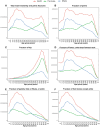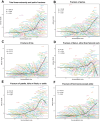Global epidemiology, burden, and causes of lower extremity and pelvic fractures in the past 32 years
- PMID: 40809766
- PMCID: PMC12343497
- DOI: 10.3389/fpubh.2025.1627867
Global epidemiology, burden, and causes of lower extremity and pelvic fractures in the past 32 years
Abstract
Background: Lower extremity and pelvic fractures (LEPFs) are common and debilitating injuries with substantial global health and economic burden, yet comprehensive epidemiological data remain limited.
Methods: Based on Global Burden of Disease 2021, we analyzed incidence, years lived with disability (YLDs), and causes of LEPFs across 204 countries from 1990 to 2021, along with their temporal trends. The impact of age, sex and Socio-Demographic Index (SDI) was considered.
Results: In 2021, 78.05 million new LEPF cases were reported globally, a 32% increase since 1990. Despite this, the age-standardized incidence rate (ASIR) declined annually by 0.68%, reaching 974.98 per 100,000 population in 2021. For anatomic subtypes, fractures of the patella, tibia or fibula, or ankle were most common (34.96 million), while hip fractures showed the largest increase for incident cases (126%) and a significant rising ASIR among males (0.21% annually). Conflict-affected countries in the Middle East and Africa saw the sharpest rises in LEPF burden. SDI correlated with elevated ASIR and age-standardized YLD rates (ASYR), particularly at SDI > 0.7. Falls were the leading cause, followed by road injuries. YLDs peaked among adults aged 45-60, with ASYR rising sharply in older populations. The disability burden increased during COVID-19 pandemic, exposing vulnerabilities in global fracture care systems.
Conclusion: LEPFs remain a significant public health challenge, driven by population aging, regional instability and osteoporosis. Hip fractures in males and LEPFs in conflict zones demand urgent attention. Strengthening fall prevention, implementing comprehensive osteoporosis management including sex-inclusive approaches, and targeted prevention strategies is essential to mitigating the global burden of LEPFs.
Keywords: GBD 2021; disease burden; epidemiology; lower extremity and pelvic fractures; risk factors.
Copyright © 2025 Li and Lin.
Conflict of interest statement
The authors declare that the research was conducted in the absence of any commercial or financial relationships that could be construed as a potential conflict of interest.
Figures





Similar articles
-
The global burden of fractures and its underlying etiologies: results from and further analysis of the Global Burden of Disease Study 2021.Arch Osteoporos. 2025 Aug 6;20(1):111. doi: 10.1007/s11657-025-01596-3. Arch Osteoporos. 2025. PMID: 40764873
-
The incidence, prevalence, and years lived with disability of forearm fractures: a systematic analysis based on the global burden of disease study 2021.Front Public Health. 2025 Jul 10;13:1598660. doi: 10.3389/fpubh.2025.1598660. eCollection 2025. Front Public Health. 2025. PMID: 40709028 Free PMC article.
-
Global, regional, and national burden of fracture of pelvis, 1990-2021: analysis of data from the Global Burden of Disease Study 2021.Front Public Health. 2025 Jun 18;13:1610604. doi: 10.3389/fpubh.2025.1610604. eCollection 2025. Front Public Health. 2025. PMID: 40606097 Free PMC article.
-
Global burden, trends and forecast analysis of extremity fractures based on GBD 2021.Int J Surg. 2025 Jul 1;111(7):4884-4897. doi: 10.1097/JS9.0000000000002449. Epub 2025 May 26. Int J Surg. 2025. PMID: 40422857
-
Global, regional, and national burden of gastroesophageal reflux disease (1990-2021): age-period-cohort analysis and Bayesian projections.Front Public Health. 2025 Jul 9;13:1576527. doi: 10.3389/fpubh.2025.1576527. eCollection 2025. Front Public Health. 2025. PMID: 40703162 Free PMC article.
References
-
- Hoveidaei AH, Nakhostin-Ansari A, Heckmann ND, Hosseini-Asl SH, Khonji MS, Razi M, et al. Increasing burden of lower-extremity fractures in the Middle East and North Africa (MENA): A 30-year epidemiological analysis. J Bone Joint Surg Am. (2024) 106:414–24. doi: 10.2106/JBJS.23.00489, PMID: - DOI - PubMed
-
- Larsen MH, Gundtoft PH, Viberg B. High mortality among elderly with surgical treated femoral fracture in comparison to other surgical treated lower extremity fractures. A population-based register study from the Danish National Patient Registry. Injury. (2025) 56:112176. doi: 10.1016/j.injury.2025.112176, PMID: - DOI - PubMed
MeSH terms
LinkOut - more resources
Full Text Sources
Medical
Miscellaneous

